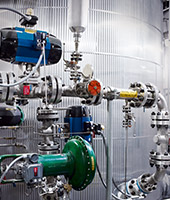Opportunities Report
Opportunity Management System
WACKER’s opportunity management system remained unchanged from the previous year. It is a divisional and Group-level instrument. We identify operational opportunities and exploit them in our business divisions, which possess the detailed product and market expertise required. We continuously use market observation and analysis tools to obtain a well-structured analysis of market, industry and competitor data, for instance. In addition, we hold customer interviews to evaluate future opportunities. The monitoring process – how WACKER seizes opportunities – is based on key indicators (such as rolling forecasts and current-status reporting).
Opportunity Management System

Strategic opportunities of vital importance – such as strategy adjustments, potential acquisitions, collaborations and partnerships – are handled at the Executive Board level. Such opportunities are incorporated into WACKER’s annual strategy-development and planning process, with current issues being discussed at regularly scheduled Executive Board meetings. For these issues, we normally use various scenarios to develop risk-opportunity profiles before making decisions.
WACKER has identified a whole range of opportunities for advancing the Group’s success over the next few years.
Overview of Business Opportunities
|
||
Overall economic opportunities |
Growth in Asia and other emerging markets |
|
Sector-specific opportunities |
Good product portfolio for megatrends, such as energy, rising affluence, urbanization and digitalization |
|
Strategic opportunities |
Expansion of our production capacities |
|
Performance-related opportunities |
Higher plant productivity |
|
Overall Economic Opportunities
Although the economic environment is becoming tougher, WACKER sees good opportunities for growth in new markets and sales regions. Our focus here is on Brazil, China, India and the Middle East. As previously, we expect the highest growth rates to be in China, India and Southeast Asia. To seize such opportunities, we are steadily expanding our presence in these markets. Our technical competence centers and the WACKER ACADEMY are pivotal in achieving WACKER’s high standard of service and customer proximity.
Sector-Specific Opportunities
Our extensive product portfolio in particular offers sector-specific opportunities by placing us in an excellent position to satisfy global megatrends. These trends remain as important as ever to our business.
Rising affluence in emerging countries, particularly in Asia, coupled with growing market and customer requirements are fueling demand for products incorporating high-quality silicones. WACKER wants to benefit from this development and further increase its proportion of highly profitable specialty silicones compared with standard products. Our main points of focus are automotive applications, cosmetics, personal care, health, medicine, electronics and clothing. We intend to support growth in these areas by launching innovative products in the personal-care, textile-impregnation /-finishing, and electronics sectors.
We see good growth prospects for WACKER SILICONES in the electrical and electronics markets, especially in the fields of lighting and automotive electronics. According to Semicast Research, the global market for electronic components in vehicles will grow by around 8 percent annually until 2020. Digital integration, a prerequisite for autonomous driving systems, is also set to accelerate in the next few years. Management consultants at McKinsey estimate that up to 50 million cars will be digitally integrated by 2025. The electronics required can only be protected reliably with silicone gels and silicone encapsulants. What is more, our products play a key role in the development of innovative safety systems. In partnership with leading automotive suppliers, we are working on developing new driver-assistance and lighting systems based on energy-saving LEDs.
WACKER POLYMERS, too, has potential for growth due to the rising affluence in emerging economies. The move away from conventional building materials and construction methods to higher quality systems will continue. A key aspect here is the use of dispersible polymer powders for modifying cement and gypsum mortars. Through the addition of these polymer powders, mortar mixtures are easier to process, can be applied more thinly and their properties can be substantially improved, too. But, so far, some 80 percent of dry-mix mortars used in the building sector are not modified. In many regions, construction experts have only just started to appreciate the benefits of polymer-modified dry-mix mortars. In particular, we are working on specialty polymer binders for gypsum-based materials for the rapidly growing drywall market. WACKER POLYMERS continues to see potential in its material-substitution business, too.
WACKER BIOSOLUTIONS primarily expects growth opportunities in contract manufacturing of pharmaceutical proteins. With fermenter capacities ranging from 300 to 1,500 liters, we believe that we are well-equipped to cover our customers’ entire supply-chain needs, from clinical testing through to supplying the market.
Energy remains a key megatrend, with the photovoltaic industry playing a major part here. The competitiveness of the solar industry compared to other energy sources continues to spur demand for solar installations. All around the globe, the use of renewable energy is increasing. We see growth potential mainly in China, India and the USA. As a producer of hyperpure polysilicon and cost and quality leader, WACKER POLYSILICON will benefit from this megatrend.
Sales Volumes: Opportunities and Risks
|
||
Risks |
Opportunities |
|
|
|
|
Weaker economic growth in China and the emerging markets |
Sales growth driven by products for cosmetics and personal care, electronics and construction |
|
Increased uncertainty due to trouble spots in the Middle East and Ukraine |
Strong solar-market growth |
|
Strategic Opportunities
Thanks to the production-capacity expansion of recent years, WACKER has opportunities for further growth at its business divisions. The investment focus is now shifting, though, toward facilities for the manufacture of downstream products. In the first quarter of 2016 we will continue the start-up process for the new polysilicon site in Tennessee (USA), which will bring fresh production capacities on stream and enable us to tap into further growth on the photovoltaic market. We likewise intend to profit from rising demand for high-grade polymer binders in the construction, paint and surface-coating industries with our new VAE dispersion reactor in Calvert City (Kentucky).
Performance-Related Opportunities
WACKER has a number of options for improving its cost structures, processes and productivity. We have identified scope for cutting costs at WACKER POLYSILICON and Siltronic and are already acting to realize these savings. The various levers for cost reductions include the specific costs for auxiliaries, productivity advances on the manufacturing side, and a broader choice of suppliers for securing more attractive purchasing terms.
At WACKER SILICONES, we are working on optimizing our integrated production network, while increasing the proportion of higher-quality products per metric ton of siloxane. For a number of years now, the Wacker Operating System (WOS) program has been helping us to realize further potential savings by optimizing our processes and increasing productivity. Specific energy consumption alone – i. e. amount of energy per unit of net production output – is to be reduced by 11 percent in Germany by 2022.




